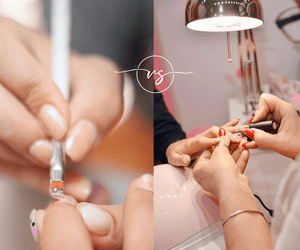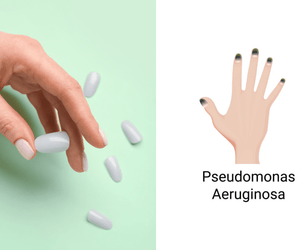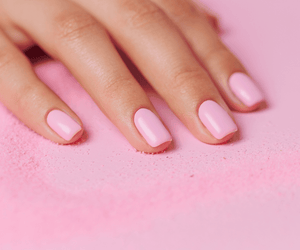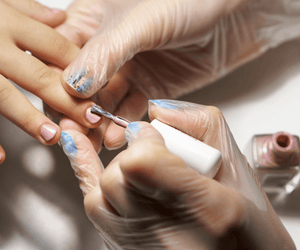Throughout history, long nails have always been associated with glamor and leisure. When acrylic nails were invented in the middle of the 20th century, they finally made long nails a reality for those who couldn’t grow them naturally. In this post, we’ll reveal the fascinating history of acrylic nails and explore the complex question of who invented fake nails first (hint: there are a few people who could take credit). Let’s dig in!
Table of Contents
Historical Concepts of Artificial Nails
There are many myths about ancient methods of extending the nails using different and sometimes strange materials. Historians haven’t written on the topic extensively, and sources often lump in nail polish-esque enhancements with more three-dimensional appliques.
Either way, the love of nails throughout history was most prominent in Ancient China, where the practice of growing long nails was associated with the royal classes. While they didn’t exactly use artificial nails, members of the royal court during the Ming (1368-1644 CE) and Qing (1644-1912) dynasties would wear nail guards. These artful objects were made of precious metals and decorated with art and gemstones.
Fun fact: During the Ming Dynasty, the very first approximation of nail polish was also created. This early nail varnish was made of beeswax, egg whites, gum arabic, and dyes.
There are also stories about women in early 19th century Greece using pistachio shells as nail adornments. While this is fun to envision, it’s likely more rumor than fact!
20th Century Inventions Before Acrylics
One of the best ways to learn about the history of acrylic and fake nails is by diving into the patents. Throughout the 30s and 40s, many inventors patented their first fake nail inventions, although a patent doesn’t mean the product ended up on the market.
In our research, we discovered products similar to the nail guards from the Ming dynasty, as well as rings designed to fit over the tips of the fingers with nail-like extensions.
There have been several patents for artificial nail extensions since 1949. British hairdresser Herman Deighton Steiner patented a nail extension form with a pocket into which the natural nail could be inserted. Whether Deighton brought his patent to market is unclear, and the product never caught on.
The Invention of Acrylic Nails
The very first acrylic nails were invented by dentist Dr. Maxwell Lappe, specifically for nail biters. These acrylics were the first fake nails, as they were designed for women to glue on at home. It is rumored that because of their thickness, these nails did not catch on.
The glamorous salon acrylic nails we know today were invented in the 1950s by dentist Dr. Fred Slack.
While working in his dental office, Dr. Slack cut his thumbnail. As a practicing dentist, he had no shortage of dental acrylic in his office since the material is used to create fillings, crowns, and veneers. He used foil to shape the acrylic into a nail-like extension, which he was then able to glue onto his thumb as a replacement.
This turned out to be a very happy accident. Dr. Slack was inspired to perfect his technique. In partnership with other family members, he eventually launched a nail company that would go on to develop many innovations in the nail world. Today, Dr. Slack’s company still provides manicurists with the materials they use in their salons!
The precise date of the invention is up for debate. According to Dr. Slack’s son, Fred Slack Jr., this story took place in 1957. However, a patent attributed to Slack’s brother Tom Slack, suggests that the story took place two years earlier.
The Development and Commercialization of Acrylic Nails
Throughout the 1960s and 70s, Dr. Slack continued to develop acrylic nail technologies, focusing on developing an acrylic nail system free from discoloration. His son eventually opened NSI, a company selling nail salon supplies.
Meanwhile, another dentist, Dr. Stuart Nordstrom, worked on a similar innovation and may have even beaten Dr. Slack to market. Both dentists developed systems that allowed manicurists to replicate the process used in dental offices. They combined acrylic powder monomer with a liquid polymer to build artificial nails that could be filed, buffed, and shaped to suit specific clients.
Throughout the 1980s, as more and more manufacturers took inspiration and entered the market, more innovations made the process of creating acrylic nails easier and the final results more life-like.
Acrylic Nails and Cultural Impact
On the consumer side, beauty salons quickly adopted any nail extension technology that has been sent their way. By the late ‘60s, many salons offered acrylic nails, and the style caught on quickly. Models on the cover of Vogue were sporting subtle artificial nails, including Donyale Luna — the first Black woman to grace the cover of the magazine.
The divas of the disco era transformed noticeable acrylic nails into a fashion statement. Icons like Diana Ross and Donna Summers showed off long, beautifully painted acrylic nails in press photos and on album covers.
The ‘70s and ‘80s gave rise to a dichotomy in the world of acrylic nails, and this continued well into the early 2000s. Some women, often ones from wealthier backgrounds, embraced a more conservative look, while others — especially women of color — opted for artistry, pushing the boundaries of nail art.
The history of Black women as beauty pioneers is marred by societal racism, exemplified by the reaction to record-setting track and field athlete Florence Griffith Joyner (aka Flo Jo). In the 1988 Olympics, Flo Jo’s acrylic nails garnered just as much attention as her record-setting gold medal win.
Today, as women of all backgrounds opt for eye-catching artificial nails, it’s important to remember the initial backlash to the style and the reasons for it.
Evolution of Artificial Nail Technology
Over the decades, artificial nail technology has undergone many transformations. Dr. Slack’s original acrylic nails were built directly over the client’s nails following forms.
Over the years, continued innovations led to new acrylic materials that largely still depended on manicurists mixing acrylic powder and liquid to create a paste. It’s hard to find specific dates, but it seems as though it was only in the 2000s that new options, like UV-cured gel nails, poly gel, and nail tips applied with acrylic, were introduced.
Who Invented Fake Nails?
The history of salon manicures is fascinating, but what about home options like press-ons? Who invented the first fake nails? Unfortunately, we couldn’t find the first company to release press-on nails, but the early innovators included TruNails and Lee Press-On Nails. Eylure, the famous false eyelash brand, took credit for developing the first temporary press-on nails that adhere with a sticky tab.
Despite their immense convenience, early iterations of press-on nails didn’t have a great reputation. They didn’t have the lasting power or natural look needed to compete with professional acrylic nails.
It’s only over the last few years that they’ve had a resurgence, in large part thanks to the closing of salons during the Coronavirus lockdowns. As a result, brands like Lilac St. have developed press-on nails with better longevity, a more flexible, life-like look, and creative designs that fit with modern style.
Conclusion
Throughout history, long nails have been a symbol of status, taste, and style. In recent years, their rising accessibility has led to manicurists and clients pushing the boundaries of creativity. If you ask us, press-on nails present the future of artificial nails! They’re just as stylish and realistic as what can be achieved in the salon, but their affordability and convenience mean their popularity will only rise.








